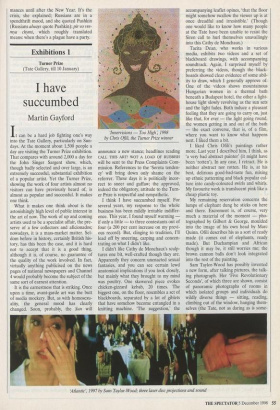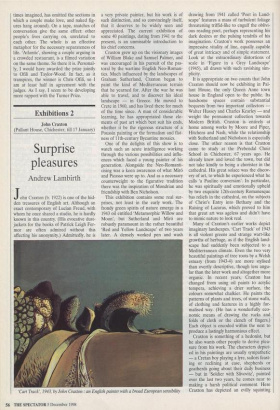Exhibitions 1
Turner Prize
(Tate Gallery, till 10 January)
I have succumbed
Martin Gayford
It can be a hard job fighting one's way into the Tate Gallery, particularly on Sun- days. At the moment about 1,500 people a day are visiting the Turner Prize exhibition. That compares with around 2,000 a day for the John Singer Sargent show, which, though badly selected and over large, is an extremely successful, substantial exhibition of a popular artist. Yet the Turner Prize, showing the work of four artists almost no visitors can have previously heard of, is almost as popular and successful. It makes one think.
What it makes one think about is the astonishingly high level of public interest in the art of now. The work of up and coming artists used to be a specialist affair, the pre- serve of a few collectors and aficionados; nowadays, it is a mass-market matter. Sel- dom before in history, certainly British his- tory, has this been the case, and it is hard not to accept that it is a good thing, although it is, of course, no guarantee of the quality of the work involved. In fact, virtually anything publicised on the news pages of national newspapers and Channel 4 would probably become the subject of the same sort of earnest attention.
It is the earnestness that is striking. Once upon a time, avant-garde art was the butt of media mockery. But, as with homosexu- ality, the general mood has clearly changed. Soon, probably, the Sun will Innervisions — Too High', 1998 by Chris Ofili, the Turner Prize winner announce a new stance; headlines reading
CALL THIS ART! WOT A LOAD OF RUBBISH
will be sent to the Press Complaints Com- mission. References to the `Serota tenden- cy' will bring down only shame on the referrer. These days it is politically incor- rect to sneer and guffaw; the approved, indeed the obligatory, attitude to the Turn- er Prize is respectful and sympathetic.
I think I have succumbed myself. For several years, my response to the whole business has been mildly irritable indiffer- ence. This year, I found myself warming if only a little — to three contestants out of four (a 200 per cent increase on my previ- ous record). But, clinging to tradition, I'll lead off by sneering, carping and concen- trating on what I didn't like.
I didn't like Cathy de Monchaux's sculp- tures one bit, well-crafted though they are. Apparently they concern unenacted sexual fantasies, and you can see certain lewd anatomical implications if you look closely, but mainly what they brought to my mind was poultry. One skewered piece evokes chicken-gizzard kebab, 20 times. The biggest one, on the floor, resembles a set of blackboards, separated by a lot of giblets that have somehow become entangled in a knitting machine. 'The suggestion,' the accompanying leaflet opines, 'that the floor might somehow swallow the viewer up is at once dreadful and irresistible.' (Though one would like to know how many people at the Tate have been unable to resist the Siren call to hurl themselves unavailingly into this Cathy de Monchaux.) Tacita Dean, who works in various media, exhibits two videos and a set of blackboard drawings, with accompanying soundtrack. Again, I surprised myself by preferring the videos, though the black- boards showed clear evidence of some abil- ity to draw, which I generally approve of. One of the videos shows mountainous Hungarian women in a thermal bath beneath a Budapest hotel, the other a light- house light slowly revolving as the sun sets and the light fades. Both induce a pleasant feeling that they are going to carry on, just like that, for ever — the light going round, the women getting in and out of the bath — the exact converse, that is, of a film, where you want to know what happens next. I liked them a bit.
I liked Chris Ofili's paintings rather more. Last year I described him, I think, as `a very bad abstract painter' (it might have been `rotten'). In any case, I retract. He is neither abstract nor rotten. He is, at his best, delirious good-bad-taste fun, mixing up ethnic patterning and black popular cul- ture into candy-coloured swirls and whirls. My favourite work is translucent pink like a cheap plastic toy.
My remaining reservation concerns the lumps of elephant dung he sticks on here and there. Excrement is, of course, very much a material of the moment — pho- tographed by Gilbert & George, moulded into the image of his own head by Marc Quinn. Ofili describes his as a sort of ready made (it comes out of elephants, ready made). But Duchampian and African though it may be, it still worries me; the brown cannon balls don't look integrated into the rest of the painting.
Sam Taylor-Wood has possibly invented a new form, after talking pictures, the talk- ing photograph. Her 'Five Revolutionary Seconds', of which three are shown, consist of panoramic photographs of rooms in which isolated groups and individuals do wildly diverse things — sitting, reading, climbing out of the window, hanging them- selves (the Tate, not as daring as is some- Atlantic, 1997 by Sam Taylor-Wood; three laser disc projections and sound times imagined, has omitted the sections in which a couple make love, and naked fig- ures hang around). On a tape, snatches of conversation give the same effect: other people's lives carrying on, unrelated to each other. The whole is an effective metaphor for the necessary separateness of life. 'Atlantic', showing a couple arguing in a crowded restaurant, is a filmed variation on the same theme. So there it is. Personal- ly, I would have awarded the prize jointly to Ofili and Taylor-Wood. In fact, as it transpires, the winner is Chris Ofili, so I am at least half in agreement with the judges. As I say, I seem to be developing more rapport with the Turner Prize.



















































































 Previous page
Previous page